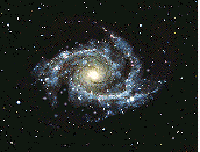- Classifying Galaxies
- Edwin Hubble at the 100 inch Telescope
 Edwin Hubble (1889-1953) guides the exposure of a
photographic plate at the Newtonian focus of the 100-inch telescope in 1923. With this
telescope, Hubble measured the distances and velocities of galaxies, work which led to
today's concept of an expanding Universe. According to this profound idea, the Universe
began ten to twenty billion years ago with a Big Bang. The receding galaxies that Hubble
observed trace the expansion of space from that dense beginning. The telescope is a
mechanical masterpiece and was dedicated as an International Historical Mechanical
Engineering Landmark on June 20, 1981, by the American Society of Mechanical Engineers,
only the fourth such award granted in the United States.
Edwin Hubble (1889-1953) guides the exposure of a
photographic plate at the Newtonian focus of the 100-inch telescope in 1923. With this
telescope, Hubble measured the distances and velocities of galaxies, work which led to
today's concept of an expanding Universe. According to this profound idea, the Universe
began ten to twenty billion years ago with a Big Bang. The receding galaxies that Hubble
observed trace the expansion of space from that dense beginning. The telescope is a
mechanical masterpiece and was dedicated as an International Historical Mechanical
Engineering Landmark on June 20, 1981, by the American Society of Mechanical Engineers,
only the fourth such award granted in the United States.

- Edwin Hubble grew up in Wheaton, Illinois, a suburb of
Chicago.
- For
a complete biography, click here.
 Before
he went on to become a famous astronomer, Edwin Hubble taught Spanish and physics as well
as coached basketball at New Albany High School, Indiana, in 1914. The New Albany High
School Yearbook "Vista" was dedicated to him.
Before
he went on to become a famous astronomer, Edwin Hubble taught Spanish and physics as well
as coached basketball at New Albany High School, Indiana, in 1914. The New Albany High
School Yearbook "Vista" was dedicated to him. - Look at the dedication page of the 1914 NAHS yearbook to see a
picture of Coach Hubble and the winning basketball team, then use the back arrow at the
top of your browser to return here.
For more information about Edwin Hubble and his system of galaxy classification
click
here, then use the back
arrow at the top of your browser to return here.
This page last updated December 12, 1997
Return to lesson
- Classifying Galaxies
- Instructions for Classification


Rotating Spiral Galaxy animation by Josh Kennedy
Look at the rotating galaxy and then at the Hubble Tuning Fork Diagram next
to it. Edwin Hubble would have classified this galaxy as type Sa.
Notice its well defined center and spiral arms.
On the next page, you will have a chance to classify some unidentified
galaxies, and use your mouse to place the galaxy images on the Hubble Tuning
Fork Diagram. To move the galaxy pictures onto the Hubble Tuning Fork Diagram
you will:
- put your mouse pointer on a galaxy image
- hold down the mouse button
- while holding down the button, move your pointer to a spot on the
diagram
- release the mouse button
When you release the mouse button, the galaxy image will move to the spot
you have selected. If you wish to move it again, you can follow the same
directions. When you have finished placing all the galaxy images on the
diagram, check your work by clicking on the the Galaxy Guy.
Start Here: Classifying galaxies
ęCopyright
2001 Regents of the University of California.
 Edwin Hubble (1889-1953) guides the exposure of a
photographic plate at the Newtonian focus of the 100-inch telescope in 1923. With this
telescope, Hubble measured the distances and velocities of galaxies, work which led to
today's concept of an expanding Universe. According to this profound idea, the Universe
began ten to twenty billion years ago with a Big Bang. The receding galaxies that Hubble
observed trace the expansion of space from that dense beginning. The telescope is a
mechanical masterpiece and was dedicated as an International Historical Mechanical
Engineering Landmark on June 20, 1981, by the American Society of Mechanical Engineers,
only the fourth such award granted in the United States.
Edwin Hubble (1889-1953) guides the exposure of a
photographic plate at the Newtonian focus of the 100-inch telescope in 1923. With this
telescope, Hubble measured the distances and velocities of galaxies, work which led to
today's concept of an expanding Universe. According to this profound idea, the Universe
began ten to twenty billion years ago with a Big Bang. The receding galaxies that Hubble
observed trace the expansion of space from that dense beginning. The telescope is a
mechanical masterpiece and was dedicated as an International Historical Mechanical
Engineering Landmark on June 20, 1981, by the American Society of Mechanical Engineers,
only the fourth such award granted in the United States. ![]()
 Before
he went on to become a famous astronomer, Edwin Hubble taught Spanish and physics as well
as coached basketball at New Albany High School, Indiana, in 1914. The New Albany High
School Yearbook "Vista" was dedicated to him.
Before
he went on to become a famous astronomer, Edwin Hubble taught Spanish and physics as well
as coached basketball at New Albany High School, Indiana, in 1914. The New Albany High
School Yearbook "Vista" was dedicated to him. 
